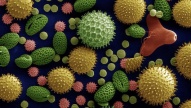
From the AAAI Rhinitis Tips:
Do you have bouts of sneezing and itching, or a runny or stuffy nose that do not seem to go away? If so, you may have rhinitis.
Rhinitis is one of the most common illnesses in the United States , affecting more than 50 million people. It often coexists with other respiratory disorders, such as asthma. Rhinitis has a significant impact on the quality of life of those who suffer from it. In addition, it can contribute to other conditions such as sinus problems, ear problems, sleep problems, and learning problems. In patients with asthma, uncontrolled rhinitis seems to make asthma worse.
Allergic rhinitis
Allergic rhinitis is caused by substances that we breathe called allergens. Allergens are usually harmless substances that can cause problems only in some people. These problems are caused because the immune system of people with allergic rhinitis mistakenly identifies these substances as intruders and generates a reaction against them. During this reaction, the immune system cells release substances such as histamine and leukotrienes that cause the symptoms of allergic rhinitis; these and other substances also cause inflammation in the nasal lining that makes the nose very sensitive to irritants such as smoke and strong odors or to changes in the temperature and humidity of the air.
Causes:
1. When allergic rhinitis is caused by common outdoor allergens, such as airborne tree, grass and weed pollens or mold, it is called seasonal allergic rhinitis, or “hay fever.”
2. Allergic rhinitis is also triggered by common indoor allergens, such as animal dander (dried skin flakes and saliva), indoor mold, droppings from dust mites and cockroach particles. This is called perennial allergic rhinitis.
Symptoms
Sneezing
Stuffy nose (congestion)
Runny nose
Itching in the nose, roof of the mouth, throat, eyes and ears
Diagnosis
If you have symptoms of allergic rhinitis, an allergist/immunologist can help determine which specific allergens are triggering your illness. He or she will take a thorough health history, and then test use to determine if you have allergies. Skin tests or blood tests are the most common methods for determining your allergic rhinitis triggers.
What to Do During Pollen Season:
When outdoor pollens are high, remain indoors, particularly in the late morning. Pollen grains can cause significant allergic symptoms like asthma and allergic rhinitis, particularly during the spring and the fall. It is difficult to avoid pollen because it is windborne and can cover wide distances. Short of moving to a different location, here are some tips for avoiding pollen during the season.
1. The pollen count is usually highest in the late morning and early afternoon particularly during sunny, windy days. The pollen count measures the concentration of a specific pollen like birch tree pollen, in the area in a specific area and time. A pollen count is a useful guide for when it is advisable to stay indoors and avoid contact with pollen.
2. Keep the windows and doors closed during the allergy season.
3. Install a room air conditioner with a special filter.The special filter (High Efficiency Particulate Air or HEPA filter) traps airborne allergens. If the house does not have central air, the best spot to put the air conditioner and filter would be the bedroom. Change the filters frequently. An allergic person should also use the car air conditioner to decrease pollen exposure when commuting. Pollen allergic persons should not have a window fan blowing into their bedroom as this will maintain outdoor pollen exposure all night.
4. Avoid working outdoors, if you must wear a special face mask. The face mask is designed to filter pollen out of the air and keep it from reaching the nasal passages.
5. Consider taking a vacation at the height of the pollen season. Preferably at a location where the pollen exposure is minimal, like the seashore.
